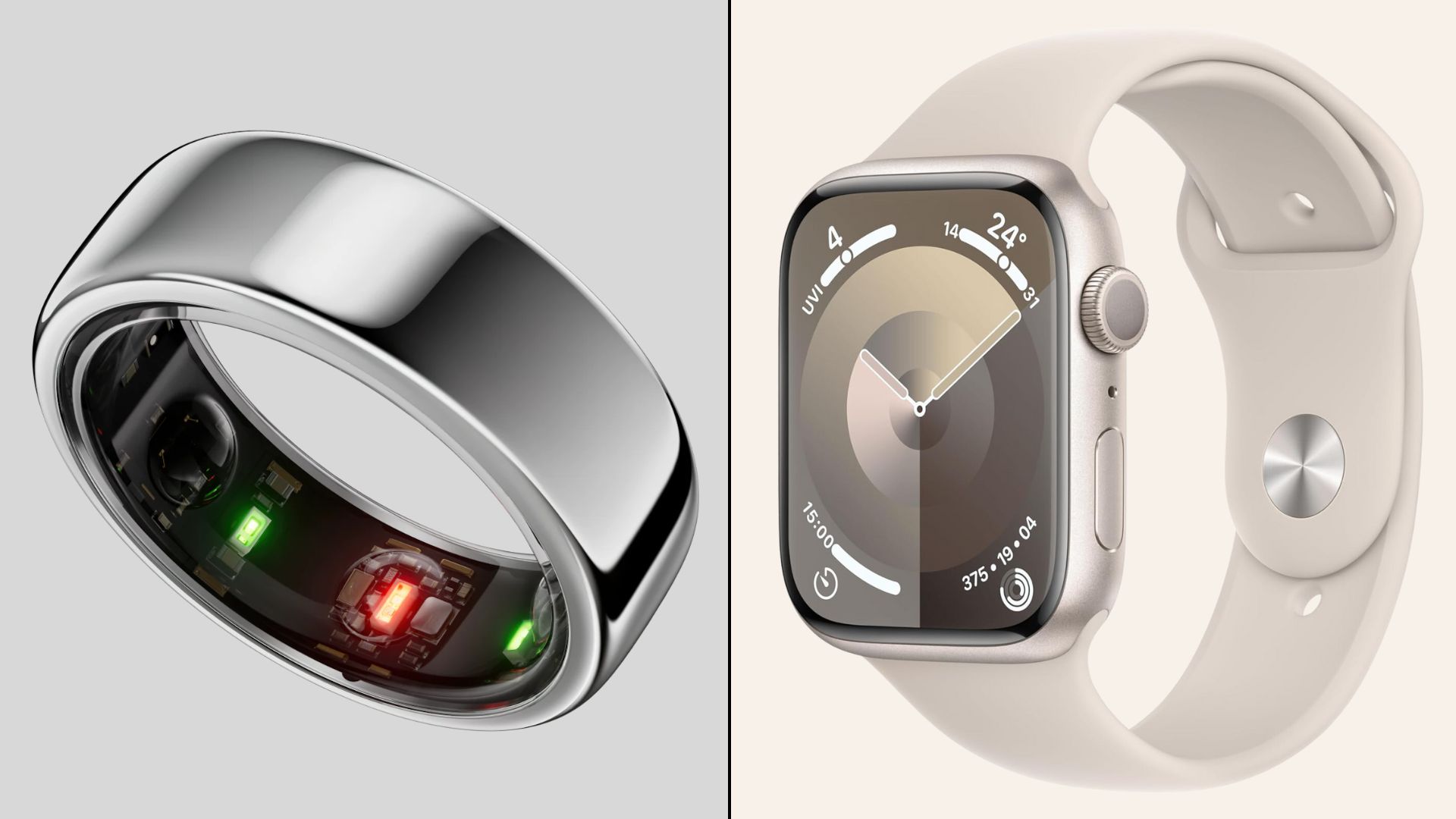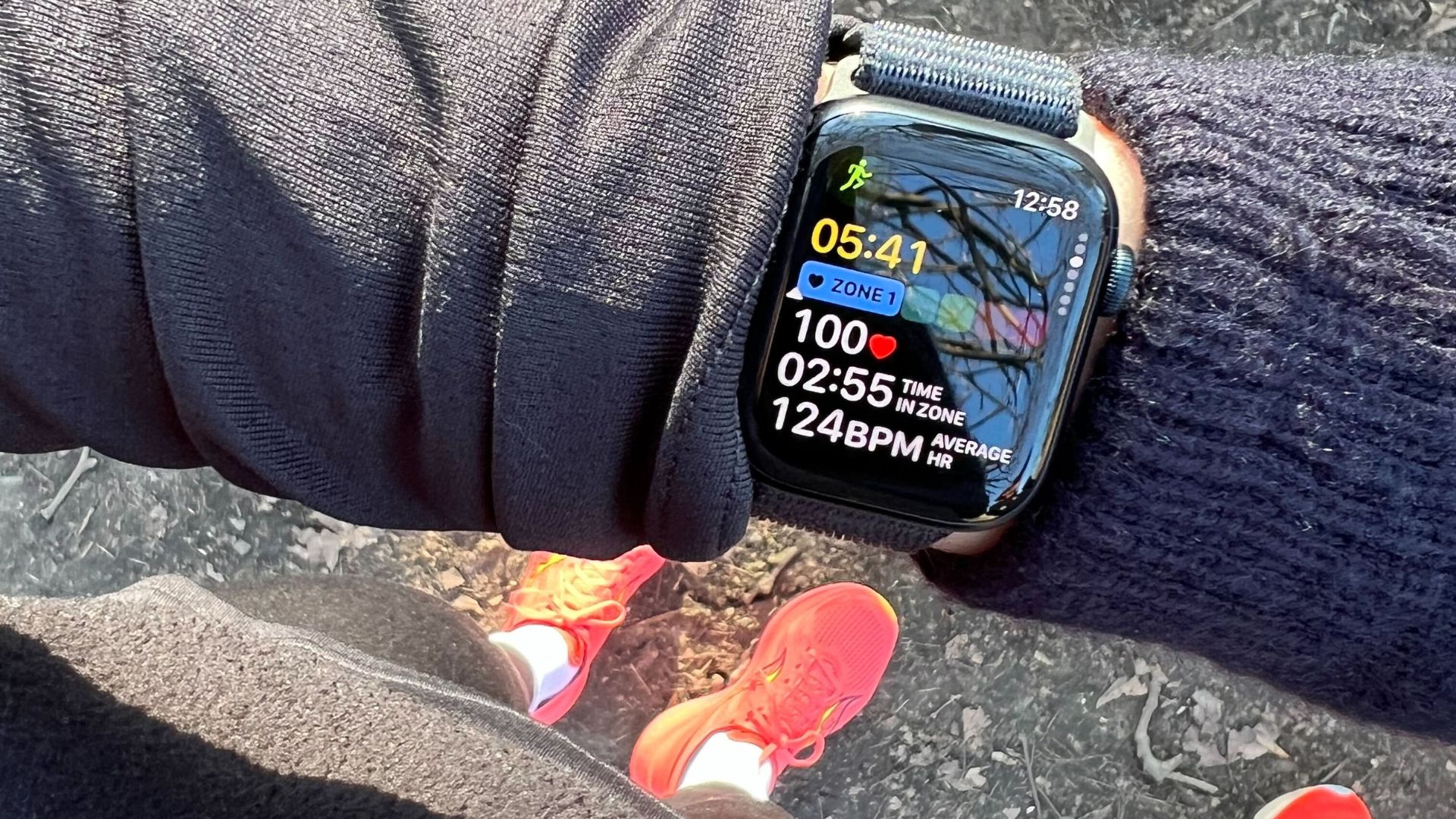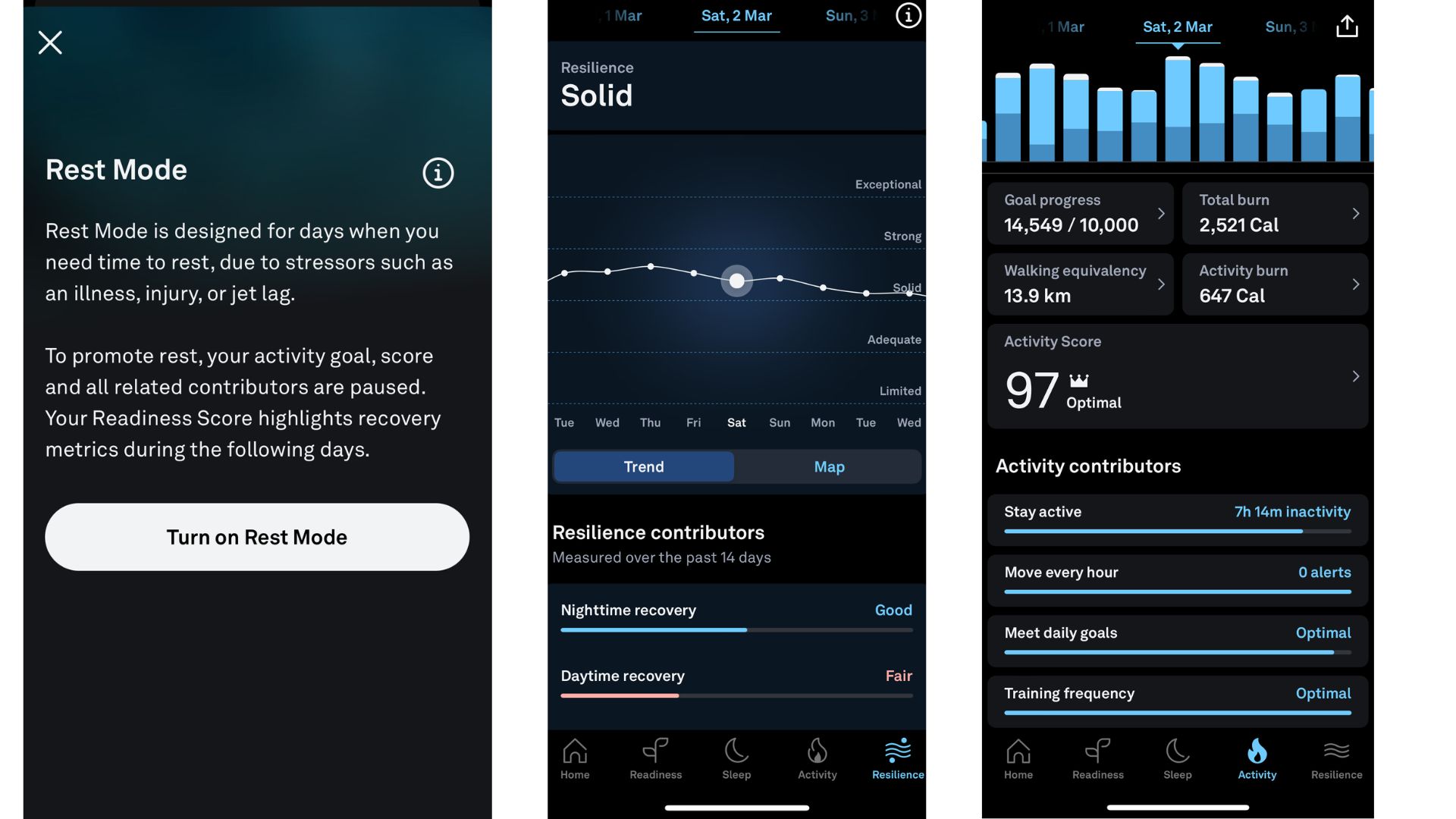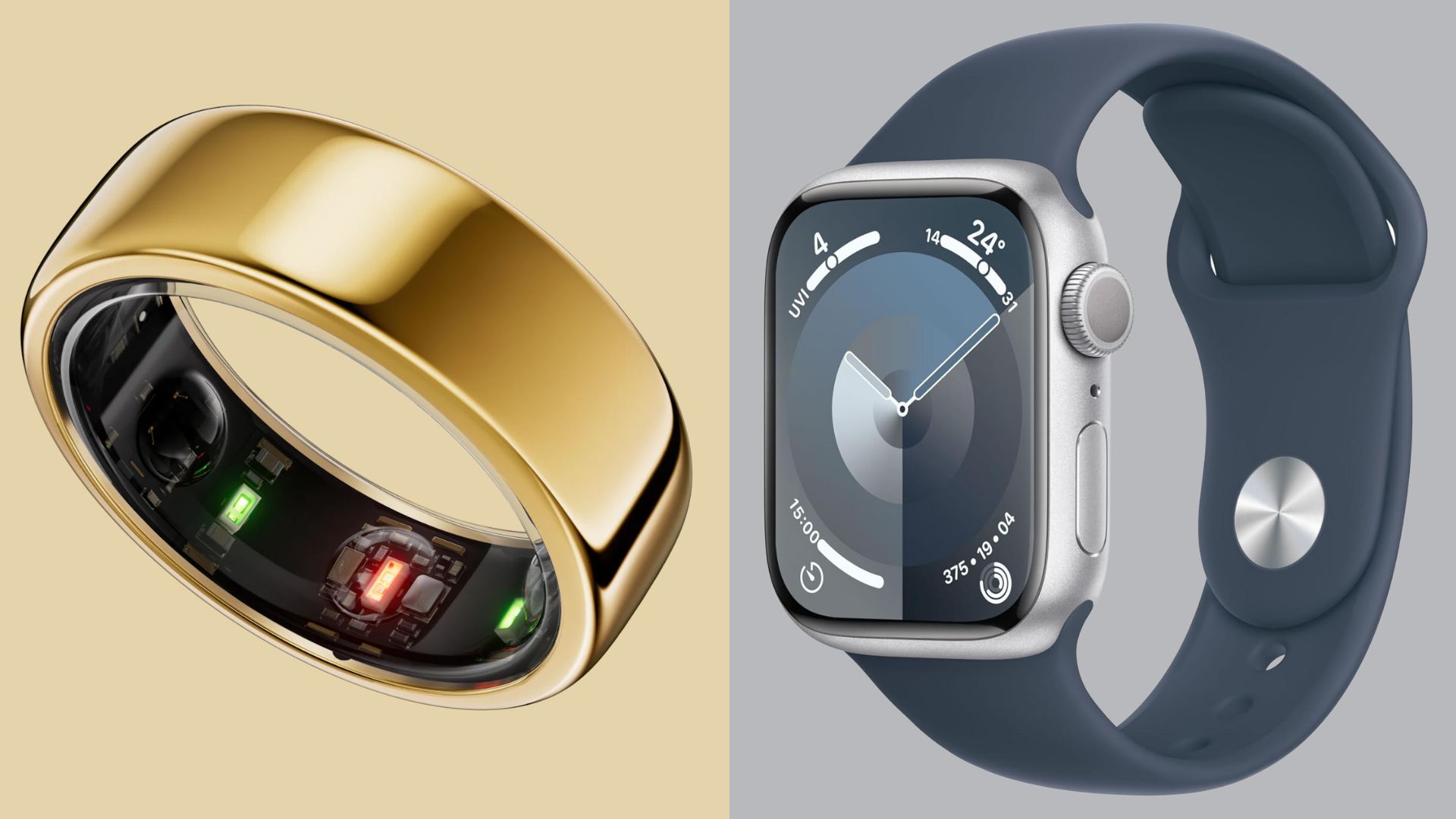
If you want to invest in a fitness tracker this year, you might be weighing up an Oura Ring vs Apple Watch. While these two wearables are very different in design, they both deliver plenty of health insights and aim to give you a greater sense of your overall health and wellbeing.
When shopping for one of the best fitness trackers, there’s lots to consider. As a health journalist who’s tested everything from the newest Fitbits to most advanced Garmin watches, I know a thing or two about what makes a good fitness wearable.
With various brands and models to choose from, it pays to do your research first and weigh up the pros and cons of each device. Perhaps you’ve already considered weighing up other brands and now have the Oura Ring on your mind. So, to help you decide which fitness wearable is best for you, I put the Oura Ring Generation 3 Horizon and Apple Watch Series 9 to the test side by side.
Oura ring vs Apple Watch
An overview
The Oura Ring and the Apple Watch Series 9 are both premium fitness trackers, coming in around the £300 mark. While the Oura Ring, as the name suggests, is designed like a ring that fits around the finger, the Apple Watch is a smartwatch worn around the wrist, which I found makes a difference when it came to statistics involving sleep and step tracking.
It's not possible to say whether one tracker is better than the other, unfortunately, since they are so different. The Apple Watch delivers insights into health and fitness not seen on any other fitness device and it's superior to the Ring in terms of GPS tracking, recording steps, and generally tracking fitness levels. As a smartwatch, it also offers lifestyle features that the Oura Ring does not as an app-based tracker. While the Apple Watch does a great job at tracking sleep, the Oura Ring is better for this as it views general health and wellbeing through the lens of rest and recovery, rather than activity.
The Oura Ring Generation 3 Horizon is one of two styles available to shop. This is the latest version, made of lightweight titanium and available in several chrome and black colourways, with a sleek and uninterrupted design.
The Apple Watch Series 9 is one of the newest Apple Watch designs, available to buy from the retailer and various other stores, including Amazon. It's the first model to use iO10, which offers new, unique features and lifestyle assistance.
Oura ring vs Apple Watch: Design
The Apple Watch Series 9 is very traditional in design, with its touch-screen watch face and a range of wrist straps. On the other hand, the Oura Ring is a relatively new design to enter the wearable world. It’s screen-free, so you have to open the Oura app on your smartphone to see your data or insights. What’s more, it’s sleekier and more compact than the Apple Watch and if you already wear lots of rings like I do, you’ll barely notice it as you go about your day.
However, if you normally wear a watch to look at the time, a device with a screen might appeal more to some. Not only can the Apple Watch display your health stats, but it comes with a variety of other lifestyle features to assist you day to day - including text and call notifications, Apple Pay, and Spotify controls. In this case, it may also help to weigh up Fitbit vs Apple Watch before making a decision, as these lower-cost devices are screen-based too.
Personally, I found it refreshing to ditch the screen and still know that my data would be ready for me when I opened the app. In a notification-filled world, I enjoyed how little I thought about my Oura Ring until I actively checked the app in the morning and the evening. It’s easier to enforce tech boundaries when you don’t have a wealth of data available at any second on your wrist.
Oura Ring vs Apple Watch: Activity tracking and performance
While the Oura Ring excels at tracking sleep and helping you learn how to sleep better, the Apple Watch really comes into its own when monitoring activity and workouts. Both devices monitor daily steps, active calorie burn, standing hours and workouts, yet the Apple Watch can support your workouts further by showing your data in real time and connecting to other fitness apps - like the Alive workout app, which I use regularly - that guide you through your workouts on the watch face.

The Oura Ring takes a more holistic approach to movement. It counts everything from running to gardening as part of your activity goals - forms of non-exercise thermogenesis (NEAT) activity that can help boost your cardiovascular health and maintain your weight, even more so than exercise. Unlike other fitness trackers, you don’t have to ‘start’ your workouts in the app with the Oura Ring. The Automatic Activity Detection will automatically detect the activity and suggest a time and intensity in the app to bank your movement. What’s more, as Oura looks at activity and recovery as a whole, it will change your movement goals daily based on your Sleep and Readiness Scores and give insight into your Resilience levels to encourage more mindful movement through an approach that prioritises rest and recovery. This was new for me - instead of trying to hit 15,000 steps a day and feeling exhausted, Oura encouraged me to tune into my body and reduce activity goals when I needed to rest.

Of course, as with any fitness tracker, it’s important to take these insights as guidance only. If you wake up feeling exhausted but your Oura or Apple Watch suggest you are well-rested, listen to your body and adjust your activity plans based on feeling.
Oura Ring vs Apple Watch: Sleep tracking
The Oura Ring was initially designed as a sleep tracker. For me, this is where it really stands out against other fitness trackers. It monitors various metrics, from total sleep, time in bed, sleep efficiency and resting heart rate. The Oura ring also monitors how much REM and Deep sleep you clocked up through the night, how quickly you fell asleep, and how much you woke up or moved around as you snoozed. These metrics determine your overall sleep score, which impacts your readiness score and indicates whether you should enjoy a day of high-intensity activities or opt for low-impact workouts and more rest. I found this new approach to activity and recovery refreshing, and I loved that Oura looked at everything through the lens of sleep and rest - much like the WHOOP 4.0.
As the Oura ring is worn on the finger, it reads data directly via the arteries. It's also one of the only devices that takes temperature directly from this part of the skin to give you accurate insights into how your body is recovering, or how illness or your menstrual cycle may impact your health.
As for the Apple Watch, you can find similar sleep insights in your Health App, including your sleep stages. You can then compare it with previous days, weeks or months. However, I found sleep data is limited with the Apple Watch compared to the wealth of information the Oura provides. I felt I better understood how I was sleeping and what changes I needed to make to improve my sleep with the Oura Ring vs Apple Watch.
Oura Ring vs Apple Watch: Battery life
It's no secret that the battery life of the Apple Watch Series 9 is the biggest downside of the device, with a lifespan per charge of just 18 hours. The Apple Watch Ultra promises up to 36 hours, but this is still less than many of the best Fitbits or the running-orientated Garmin watches. I found myself charging my Apple Watch every few days, especially if I was using GPS functions and connecting to other apps.
However, I was happy with the battery life of the Oura Ring. The brand says the Ring can last up to seven days, but I found I got around five days using all the features (including the Workout Heart Rate, Explore Content and Blood Oxygen Sensing which can reduce battery life), which is pretty standard across the fitness tracker market.
If you're looking for a device that can truly stand the test of a busy week, a device like the Fitbit Inspire 3 (10 days battery life) or the Garmin Venu Sq 2 (11 days battery life) may be a better option.
Oura Ring vs Apple Watch: Price
When it comes to the price of the Oura Ring vs Apple Watch, there isn’t much difference. The Oura Heritage starts at £299 or £349 for the Horizon, with the Apple Watch SE priced at £219 and the Series 9 starting at £399.
Unlike the Apple Watch though, buying the Oura Ring means you'll also need to order a sizing kit before purchasing to ensure you buy the right ring size. The sizing kit comes with eight plastic rings in different sizes to help you find your perfect fit. This does add a step to the process and an extra few days before you can get started with your fitness tracker.
The Oura Ring also comes with an app subscription that costs £5.99 per month, and while this is an extra and recurring cost, I think it’s worth it if it's in your budget. In fact, without this subscription, I’m not sure the Oura Ring would have the same appeal as you would only have access to your three daily scores (Readiness, Sleep, and Activity). You also wouldn’t be able to see any data that contributed to those scores, such as activity levels, heart rate variability, sleep cycles, and more. In fact, without this subscription, I'd go as far as to say the Oura Ring isn't any better than the most basic fitness tracker on the market - which costs well below the £299 price tag.
- Shop the Oura Ring Generation 3 Horizon from £349 direct from the retailer
- Shop the Apple Watch Series 9 from £399 from Apple

Is the Oura Ring or Apple Watch more accurate for steps?
I paid close attention to the step count on my Oura Ring vs my Apple Watch over several days, and often noticed variations in the count. On one particular day, Oura calculated that I had taken around 2,000 more steps than my Apple Watch had done. The Oura also suggested that in 12,000 steps, I’d managed to clock up 11km which left me sceptical as I would have been expecting around 9-10km for this number of steps.
It’s hard to tell which device was more accurate here. It was a particularly active day and both devices counted well over 10,000 steps - but with the Apple Watch regarded as one of the most accurate devices on the market, it did leave me questioning whether the Oura had overestimated my movement for the day. However, it could just be the case that I needed to wear my ring for a few more weeks to ensure accurate calibration.
In cases like this though, it's worth weighing up other options - Fitbit vs Garmin, as these devices are also designed to monitor this all-important metric.
Is the Oura Ring better than Apple Watch?
Weighing up the Oura Ring vs Apple Watch comes down to what you are looking for. One isn’t better than the other - it’s all about personal preference.
The Oura Ring is best for those who want to look at their overall health through the lens of sleep, readiness, and activity. As Oura takes a more holistic approach that focuses on sleep and recovery and adjusts activity recommendations based on the data it collects for optimal health, it can help you tune into your body and encourage you to rest. The Ring even has a Rest Mode, which the app encourages you to activate if your Readiness score is low. This helps you to focus on rest and recovery and pauses your activity goal and score. It's also useful when you go on holiday and know you won't exercise.
The Apple Watch is a smartwatch with all the bells and whistles. It provides sleep insights and tracking activity, but it also acts as a watch, can be used with Apple Pay, offers on-screen workouts, and can send text messages and make calls. It’s an all-rounder and a better choice for those considering investing in one of the best smartwatches to do more than track health statistics.







